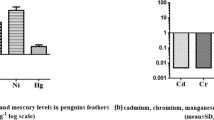Abstract
The cadmium contamination mechanism in bird feathers was investigated using starlings fed with diets containing 10 and 50 ppm Cd for five months. The experiment started about two months before the beginning of the annual complete feather molt and lasted until most of the birds completed the molt of the primaries. Concentrations of Cd in liver, kidney, and uropygial gland were highly correlated, but uropygial gland concentration was about 100 times lower. Cadmium was found both in old and new feathers, in a dose-related manner. Old. feathers showed higher metal concentrations than new ones and primaries higher than secondaries. Feather Cd concentration correlated with Cd concentration in liver, kidney, and the uropygial gland. The use of bird feathers are, therefore, a reliable method for monitoring cadmium pollution, but differences between feather type and age must be considered to correctly interpret data collected in the field.
Similar content being viewed by others
References
Appelquist H, Drabaek I, Asbirk S (1985) Variation in mercury content of Guillemot feathers over 150 years. Mar Pollut Bull 16:244–248
Berg W, Johnels AG, Sjöstrand B, Westmark T (1966) Mercury content in feathers of Swedish birds from the past 100 years. Oikos 17:71–83
Braune BM, Gaskin DE (1987) Mercury levels in Bonaparte's Gull (Larus philadelphia) during autumn molt in the Quoddy region, New Runswick, Canada. Arch Environ Contain Toxicol 16:539–549
Buggiani SS, Rindi S (1980) Lead toxicosis and salt glands in domestic ducks. Bull Environ Contain Toxicol 24:152–155
Burger J, Gochfeld M (1991) Lead, mercury, and cadmium in feathers of tropical terns in Puerto Rico and Australia. Arch Environ Contam Toxicol 21:311–315
Cheng L, Schulz-Baldes M, Harrison CS (1984) Cadmium in ocean skaters,Holobates sericeus (Insecta), and their seabird predators. Mar Biol 79:321–324
Feare CJ (1984) The starling. Oxford University Press, Oxford
Frank A (1986) In search of biomonitors for cadmium: cadmium content of Swedish fauna during 1973–76. Sci Tot Environ 7:249–256
Friberg L, Kjellström T, Nordberg GF (1986) Cadmium. In: Friberg L, Nordberg GF, Vuok VB (eds) Handbook on the toxicology of metals. Elsevier, Amsterdam, p 249
Furness RW, Muirhead SJ, Woodburn M (1986) Using bird feather to measure mercury in the environment: relationship between mercury content and moult. Mar Pollut Bull 17:27–30
Ginn HB, Melville DS (1983) Moult in birds. British Trust for Omithology, Tring, UK
Gochfeld M, Burger J (1987) Heavy metal concentrations in the liver of three duck species: influence of species and sex. Environ Pollut 45:1–16
Gochfeld M, Saliva J, Lesser F, Shukla T, Bertrand D, Burger J (1991) Effects of color on cadmium and lead levels in avian contour feathers. Arch Environ Contain Toxicol 20:523–526
Goede AA, De Bruin M (1984) The use of bird feather parts as a monitor for metal pollution. Environ Pollut 8:281–298
—, — (1985) Selenium in a shore bird, the Dunlin from Dutch Wadden Sea. Mar Pollut Bull 16:115–117
Honda K, Min BL, Tatsukawa R (1986) Distribution of heavy metals and their age-related changes in the Eastern Great White Egret,Egretta alba modesta, in Korea. Arch Environ Contain Toxicol 15:185–197
Howarth DM, Hubert AJ, Horning D (1981) A comparative study of heavy metal accumulation in the tissues of the crested tern,Sterna bergii, breeding near industrialized and non-industrialized areas. Austr Wildl Res 8:665–672
Howarth DM, Grant TR, Hulbert AJ (1982) A comparative study of heavy metal accumulation in the tissues of the crested tern,Sterna bergii, breeding near an industrial port before and after harbour dredging and ocean dumping. Austr Wildl Res 9:571–577
Jacob J, Ziswiler V (1982) The uropygial gland. In: Farner DS, King JR, Parkes KC (eds) Avian biology. Academic Press, New York, p 199
Kooiker G (1986) Schwermetalle In Federn von Elstern (Pica pica). J Omithol 127:25–36
Lindberg P, Odsjö T (1983) Mercury levels in feathers of peregrine falcon compared with total mercury content in some of its prey species in Sweden. Environ Pollut 33:143–152
Osborn D, Harris MP, Nicholson JK (1979) Comparative tissue distribution of mercury, cadmium and zinc in three species of pelagic seabirds. Com Biochem Physiol 64:61–67
Sokal RR, Rohlf FJ (1981) Biometry (2nd ed). Freeman & Co, New York
Stock M, Herber RFM, Geron HMA (1989) Cadmium levels in oyster-catcherHaematopus ostralegus from the German Wadden Sea. Mar Ecol Progr Set 53:227–234
Svensson L (1984) Identification guide to European passerines. British Trust for Ornithology, Tring, UK
Tataruch F, Lidauer R (1984). Die Amsel (Turdus merula) als Bioindikator für die Umwelbelastung mit Blei, Cadmium und Quecksilher. Ökol Vögel 6:185–194
Westmark T, Odsjö T, Johnels AG (1975) Mercury content of bird feather before and after Swedish ban on alkyl mercury in agriculture. AMBIO 4:87–92
Weyers B, Glück E, Mohl C, Stoeppler M (1985). Environmental monitoring of heavy metals with birds as pollution integrating monitors III. Fate and content trace metals in Blackbirds food, organs and feathers for a highly polluted and control area. In: Lekka TD (ed.) Heavy metals in the environment. Int Conf Athens, Sep 1985, 1:718–720
Weyers B, Glück E, Stoeppler M (1988) Investigation of the significance of heavy metal content of blackbird feathers. Sci Tot Environ 77:61–67
Author information
Authors and Affiliations
Rights and permissions
About this article
Cite this article
Pilastro, A., Congiu, L., Tallandini, L. et al. The use of bird feathers for the monitoring of cadmium pollution. Arch. Environ. Contam. Toxicol. 24, 355–358 (1993). https://doi.org/10.1007/BF01128733
Received:
Revised:
Issue Date:
DOI: https://doi.org/10.1007/BF01128733




